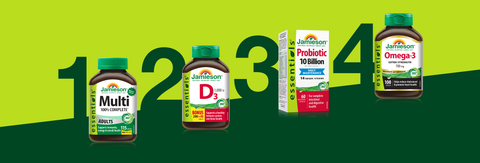If you’re one of the millions of Canadians who suffer with chronic joint pain as a result of simple wear and tear associated with aging, or because of hard training, overuse, or past injuries, it’s time to put down those pain killers and reach for some safe and effective natural alternatives.
Unfortunately, wear and tear on the musculoskeletal system starts early on - from about the age of 30, bone density begins to diminish in both men and women.1 As we age, the cartilage inside our joints becomes thinner, and components of the cartilage responsible for the cartilage's resilience become altered, which can damage the integrity of our joints long term.1 As if that weren’t enough, once we hit 30, we also start to experience a gradual loss of muscle (a condition known as sarcopenia) - a process that progresses slowly over time. Sarcopenia results in both a loss of muscle mass and muscle strength and puts increased stress on our weight-bearing joints (such as our knees and hips).
Healthy Joint Basics
Research has established that nutrition plays a central role in musculoskeletal health throughout life.2 A diet that is low in sugar, and high in collagen, glucosamine, and chondroitin-rich foods like bone broth, fruits and vegetables, and healthy fats provides your musculoskeletal system with the nutrients it needs to remain strong and resilient, and to recover from everyday injuries.
Regular physical exercise in conjunction with an overall healthy lifestyle has also been shown to promote optimal physical and mental health across the lifespan3, as well as to maintain joint flexibility and prevent joint stiffness.4 A combination of both of cardiovascular exercise and resistance training has been shown to multiply the benefits to health.5
In addition, there are a variety of effective natural solutions that can help optimize joint health, as well as help relieve some of the most common musculoskeletal symptoms, we encounter including stiffness, reduced range of motion and difficulty walking.
Natural Supplement Solutions for Healthy Joints
Glucosamine
A natural substance found in cartilage; glucosamine is probably one of the most well-known supplements for joint health. In a nutshell, glucosamine stimulates the manufacture of glycosaminoglycans, which are key components of cartilage and connective tissue. Research has shown that glucosamine sulfate is a factor in maintaining healthy cartilage and/or joint health. It helps to relieve joint pain associated with osteoarthritis; helps to relieve pain associated with osteoarthritis of the knee; and helps to protect against the deterioration of cartilage.6
Glucosamine also possesses powerful anti-inflammatory properties, so naturally helps reduce inflammation, as well as joint pain and swelling.7 Jamieson offers many glucosamine options, in varying doses, formats – some with the addition powerful supportive joint nutrients.
NEM
Natural Eggshell Membrane (NEM) (yes, the actual membrane that lines the inside of eggshells!) is a rich source of glycosaminoglycans, including chondroitin sulfate and hyaluronic acid, which are responsible for supporting the most important structural proteins in the body - collagen and elastin. Interestingly, the word collagen is derived from the Greek word kola - meaning “glue” and is what gives joints their flexibility and strength and allows fluid movements. An adequate supply of collagen helps maintain joint integrity. NEM also enhances the production of chondroitin sulfate – a critical component of cartilage. Studies have shown that supplementing with NEM is effective at reducing joint pain and stiffness associated with osteoarthritis.8 Of course not all NEM is created equal. Jamieson JointRelief™ supplies Ovomet®, a patented NEM extract which helps reduce joint pain and stiffness associated with chronic joint pain; helps relieve stiffness associated with chronic joint pain; helps support joint health by reducing joint pain and stiffness; and helps reduce joint pain in knee osteoarthritis as early as 5 days.13
Vitamin D
Vitamin D deficiency is one of the most common deficiencies worldwide.9 Without adequate Vitamin D, our bodies simply cannot effectively absorb calcium, which is essential to good strong and dense bones. Vitamin D is also important for musculoskeletal health in general, and most specifically joint health – in fact, the physical symptoms of vitamin D deficiency can include muscle weakness10 and pain and swelling in the joints, including rheumatoid arthritis pain.11 Jamieson offers a wide variety of Vitamin D options in various doses, as well as alternative formats: tablets, sprays, gummies, softgels, chewables and drops.
Multivitamins
Last but certainly not least, a solid multivitamin that supplies all of the essential vitamins and minerals, can go a long way to ensuring your bones, joints and muscles receive all of the nutrients they need not only to perform, but to thrive across your lifespan. In addition, a quality multivitamin can help complete nutritional profile and potentially make up for any nutritional gaps at times when you’re just too busy and can’t take the time to make fresh, home cooked meals.12 Jamieson 100% Complete Multivitamin For Adults reflect the latest research on nutrients vital for your optimal health.
Joint Health is something most people don’t really think about until something starts hurting, or flexibility is compromised, yet when it comes to your joints, maintenance and prevention are key. With clean and healthy nutrition, regular exercise and the right supplements, you can hold onto your flexibility and mobility well into old age!
References:
- Alexandra Villa-Forte, MD, MPH. Effects of Aging on the Musculoskeletal System. Merck Manuel Consumer Version. Review/revision Dec 201. https://www.merckmanuals.com/en-ca/home/bone,-joint,-and-muscle-disorders/biology-of-the-musculoskeletal-system/effects-of-aging-on-the-musculoskeletal-system
- Charlotte Beaudart, Dolores Sanchez-Rodriguez, Médéa Locquet, Jean-Yves Reginster, Laetitia Lengelè, Olivier Bruyère. Malnutrition as a Strong Predictor of the Onset of Sarcopenia. Reprinted from: Nutrients 2019, 11, 2883, doi:10.3390/nu11122883
- Briguglio, M., Vitale, J. A., Galentino, R., Banfi, G., Zanaboni Dina, C., Bona, A., Panzica, G., Porta, M., Dell'Osso, B., & Glick, I. D. (2020). Healthy Eating, Physical Activity, and Sleep Hygiene (HEPAS) as the Winning Triad for Sustaining Physical and Mental Health in Patients at Risk for or with neuropsychiatric disorders: Considerations for Clinical Practice. Neuropsychiatric disease and treatment, 16, 55–70. https://doi.org/10.2147/NDT.S229206.
- Johns Hopkins Arthritis Center: https://www.hopkinsarthritis.org/patient-corner/disease-management/role-of-exercise-in-arthritis-management
- Yoo, S. Z., No, M. H., Heo, J. W., Park, D. H., Kang, J. H., Kim, S. H., & Kwak, H. B. (2018). Role of exercise in age-related sarcopenia. Journal of exercise rehabilitation, 14(4), 551–558. https://doi.org/10.12965/jer.1836268.134.
- Health Canada Natural Product Ingredients Database, consulted July 1st, 2021 at: http://webprod.hc-sc.gc.ca/nhpid-bdipsn/atReq.do?atid=glucosamine.sulfate&lang=eng
- Reginster, J. Y., Neuprez, A., Lecart, M. P., Sarlet, N., & Bruyere, O. (2012). Role of glucosamine in the treatment for osteoarthritis. Rheumatology international, 32(10), 2959–2967. https://doi.org/10.1007/s00296-012-2416-2.
- Ruff, K. J., DeVore, D. P., Leu, M. D., & Robinson, M. A. (2009). Eggshell membrane: a possible new natural therapeutic for joint and connective tissue disorders. Results from two open-label human clinical studies. Clinical interventions in aging, 4, 235–240. https://doi.org/10.2147/cia.s5797.
- Sizar O, Khare S, Goyal A, et al. Vitamin D Deficiency. [Updated 2021 Jan 3]. In: StatPearls [Internet]. Treasure Island (FL): StatPearls Publishing; 2021 Jan-. Available from: https://www.ncbi.nlm.nih.gov/books/NBK532266/.
- Nair, R., & Maseeh, A. (2012). Vitamin D: The "sunshine" vitamin. Journal of pharmacology & pharmacotherapeutics, 3(2), 118–126. https://doi.org/10.4103/0976-500X.95506.
- Kostoglou-Athanassiou, I., Athanassiou, P., Lyraki, A., Raftakis, I., & Antoniadis, C. (2012). Vitamin D and rheumatoid arthritis. Therapeutic advances in endocrinology and metabolism, 3(6), 181–187. https://doi.org/10.1177/2042018812471070.
- Harvard T.H. Chan School of Public Health. Nutrition Insurance Policy: A Daily Multivitamin. The Nutrition Source. Accessed Jan 23, 2018 at: https://www.hsph.harvard.edu/nutritionsource/multivitamin/
- https://health-products.canada.ca/lnhpd-bdpsnh/info.do?licence=80103207




